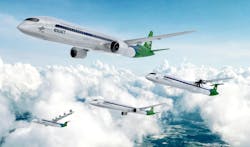Germany's DLR announces expanded low-carbon flying strategy
COLOGNE, Germany - The German Aerospace Center (Deutsches Zentrum für Luft- und Raumfahrt; DLR) in Cologne has finalized its aviation strategy aimed at reducing the carbon footprint of flying. The strategy, which addresses carbon and non-carbon emissions, proposes solutions to mitigate aviation's impact on climate change.
DLR's Aviation Strategy outlines a pathway toward achieving climate-neutral flying by mid-century. Collaborating with the aviation industry and research institutions, DLR conducts comprehensive research on aircraft concepts, propulsion solutions using sustainable energy sources, and climate-optimized flight routes.
"About half of the climate impact of aviation stems from non-carbon effects," stated Markus Fischer, DLR Divisional Board Member for Aeronautics. "Contrails and the resulting contrail cirrus clouds play a significant role. Climate-optimized flight routes offer a promising avenue for mitigating non-carbon effects, emphasizing the need to demonstrate their commercial viability and efficacy in the years ahead. Increased automation, standardization, and a robust policy framework are also crucial."
The strategy also underscores the importance of a diverse range of low-emission propulsion concepts and sustainable energy sources. Future aircraft configurations may include battery or hybrid-electric systems for small and regional flights, hydrogen power for short-haul routes, and sustainable fuels combined with highly efficient gas turbines for medium- to long-haul journeys.
Furthermore, the development, qualification, and certification of aircraft will increasingly rely on simulation-based methods to accelerate innovation, mitigate risks, and expedite the introduction of new technologies to market.
"The journey towards eco-friendly aviation necessitates substantial research and development efforts," Fischer added. "DLR's strategy identifies key challenges, including halving the energy requirements of future aircraft by 2050. This demands innovations to reduce aerodynamic drag, and weight, and the adoption of new system architectures."
